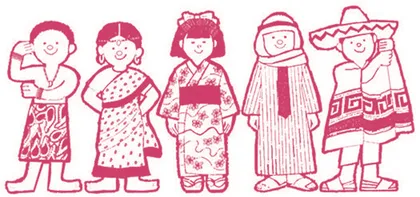Traditional Dress Around the World世界各地的传统服饰
作者: 艾丽丝·帕克 黄媛/译

From the Indian sari, to the Vietnamese conical hat, the world is full of varieties of traditional dress. While some are immersed in history and specific to the country’s culture, and others represent circumstance or status, they are almost always eye-catching.
从印度的纱丽到越南的斗笠,这世上的传统服饰种类繁多。一些服饰受到了历史的浸润,为特定国家文化所特有,还有一些是环境或地位的象征,但不变的是,它们几乎总是光彩夺目的。
Given that learning about traditional garb gains insights into the country they’re part of, we’ve rounded up a few items to give you a lowdown1 on traditional dress around the world.
鉴于了解传统服饰有助于了解其所在的国家,我们收集了一些单品,让您一览世界各地传统服饰之风采。
The Sari, India
印度纱丽
Ostensibly the simplest item of clothing possible—a single length of fabric, up to nine metres long—the sari is also one of the world’s most versatile and stylish garments, which can be draped in dozens of different ways. The sari spans all of Indian society, from simple cotton versions that are woven in the street throughout the villages of India to extremely glamorous contemporary styles that grace the catwalk2 during India Fashion Week.
乍一看,纱丽是最为简单的服饰——不过是一块可长达九米的布料而已——但它也是世上最百搭、最时尚的服饰之一,可以用数十种不同的方式披在身上。整个印度社会各阶层妇女都穿纱丽,既有印度各村街边织造的简单朴素的棉质纱丽,也有印度时装周T台展示的极尽华丽的现代纱丽。
Kilts, Scotland
苏格兰短裙
From Braveheart to Strictly Come Dancing, the kilt has been used to represent all things Scottish. Visit any Scottish Highland Games, and you’ll see that kilt-wearing traditions are alive and well, from the immaculately3 dressed competitive dancers to the pipe4 players in formal attire and, most impressively of all, the participants in the “heavy events”—for you cannot toss a caber5 properly unless wearing a kilt.
从电影《勇敢的心》到综艺《舞动奇迹》,苏格兰短裙一直被视为当地的象征。参观任何一场苏格兰高地运动会,您都会发现,穿着苏格兰短裙的传统完好地延续至今:无论是衣着整洁的竞技舞者,还是身着盛装的风笛手,都穿苏格兰短裙。给人印象最深刻的,非参加“重量级”抛杆赛的选手们莫属——除非穿上苏格兰短裙,否则这项运动的苏格兰特色就得大打折扣。
Tracht, Southern Germany and Austria
德国南部和奥地利的日耳曼民族服装
Tracht—that’s lederhosen for men and dirndls6 for women—is the traditional dress across southern Germany and Austria. There are many variations on the basic styles depending on the area and on fashion, from the pom-pom hats of the Black Forest7 (bollenhut) to thoroughly modern versions.
说到德国南部和奥地利的日耳曼民族服装,男装要数皮短裤,女装则为紧腰阔摆连衣裙。根据地区和时尚的不同,基本款式亦有诸多变化,从德国黑林山的大绒球帽到现代感十足的款式,不一而足。
Balinese temple dress, Indonesia
印度尼西亚巴厘岛寺庙礼服
Anyone visiting a Balinese temple in Indonesia should at least wear two basic elements of Balinese traditional dress, a sash (selendang) and a sarong-style skirt known as a kain. However, the full Balinese outfit for women, which also includes the kebaya blouse, is an elaborate ensemble worn for temple festivals that shows off Bali’s gorgeous textiles, such as ikat8 weaving and batik, to the full.
任何来印度尼西亚巴厘岛寺庙观光的香客,应至少穿戴巴厘岛传统服装中的两个基本单品:一条腰带(当地人称selendang)和一条当地人称为kain的纱笼裙。巴厘岛女性为寺庙节日精心备制的全套礼服,包括可峇雅衬衫,充分展示了巴厘岛华丽的纺织工艺,如纱线扎染和蜡染技艺。
Maasai beadwork, Kenya
肯尼亚马萨伊珠饰
One of the smaller ethnic groups in Kenya, but one of the most recognisable, the Maasai’s reputation worldwide belies its size, no small part thanks to their stunning attire: brilliant red cloth, extraordinarily intricate beadwork and—for young men—long, ochre9-dyed hair. The beadwork in particular contains much meaning, a bride’s collar being the pinnacle of Maasai craftsmanship.
马萨伊族虽是肯尼亚较小的民族之一,却也是最为知名的民族之一。尽管人口不多,却能在世界上获得广泛声誉,这在很大程度上要归功于他们绝美的装束:鲜艳的红色布料、巧夺天工的珠饰,以及年轻男子染成赭红色的长发。珠饰的内涵尤其丰富。新娘的项圈是马萨伊工艺的巅峰之作。
Herero women, Namibia
纳米比亚赫雷罗族女性服饰
The traditional dress of the Herero women in Namibia is an adaptation of Victorian dress, as worn by the German colonists they fought in a bloody conflict at the start of the twentieth century, and now retained as a proud part of Herero identity. The silhouette is distinctive: a full, floor-length skirt, fitted bodice with puffed sleeve, with a magnificent horn-shaped hat, the shape of cattle horns, completing the look.
纳米比亚赫雷罗女性的传统裙装源自维多利亚时代的裙装。20世纪初,德国殖民者就穿着这种衣服——当时,赫雷罗族人为反抗殖民者而浴血奋战。如今,这种服饰作为赫雷罗身份令人自豪的遗产留存下来。其造型特色鲜明:一袭及地长裙,上衣贴合身线,袖子蓬松,再配上一顶华丽的牛角形帽子,造型便更加完美。
Sámi clothing, Lapland
拉普兰地区萨米族服装
The northernmost reaches of Norway, Sweden and Finland, and the Kola peninsula of northwest Russia, are home to the Sámi, who are among the oldest peoples in Europe.
萨米族是欧洲最古老的民族之一,挪威、瑞典和芬兰的最北端和俄罗斯西北部的科拉半岛是萨米人的家园。
There are variations in costume throughout the region, though the main item is the kolt (or gákti in northern Sámi), a tunic or dress. The simple bright colours of blue, red, yellow and green always feature and reindeer skin and fur is used for belts, boots and gloves.
整个地区的服装各有差异,但主要服装是kolt(北萨米语称之为gákti),这是一种长罩衣或连衣裙式的服装。这种服装以蓝、红、黄、绿这些简单明快的颜色为主。腰带、靴子和手套则由驯鹿的皮毛制作而成。
Gho, Bhutan
不丹果袍
In Bhutan, a tiny Himalayan kingdom tucked between China and India, it’s obligatory for everyone to wear the national dress. For men this means the gho, a knee-length gown tied at the waist by a belt called a keram.
在喜马拉雅山脚、中国和印度两国之间坐落着一个迷你王国——不丹,这里人人都必须穿着民族服装。男性身着及膝果袍,用一种叫作keram的带子束于腰间。
For formal occasions a silk scarf, a kabney, is added to the ensemble, the colour of which depends on the wearer’s status. For the women, traditional dress is typically an ankle-length dress called a kira, and the equivalent scarf is called a rachu.